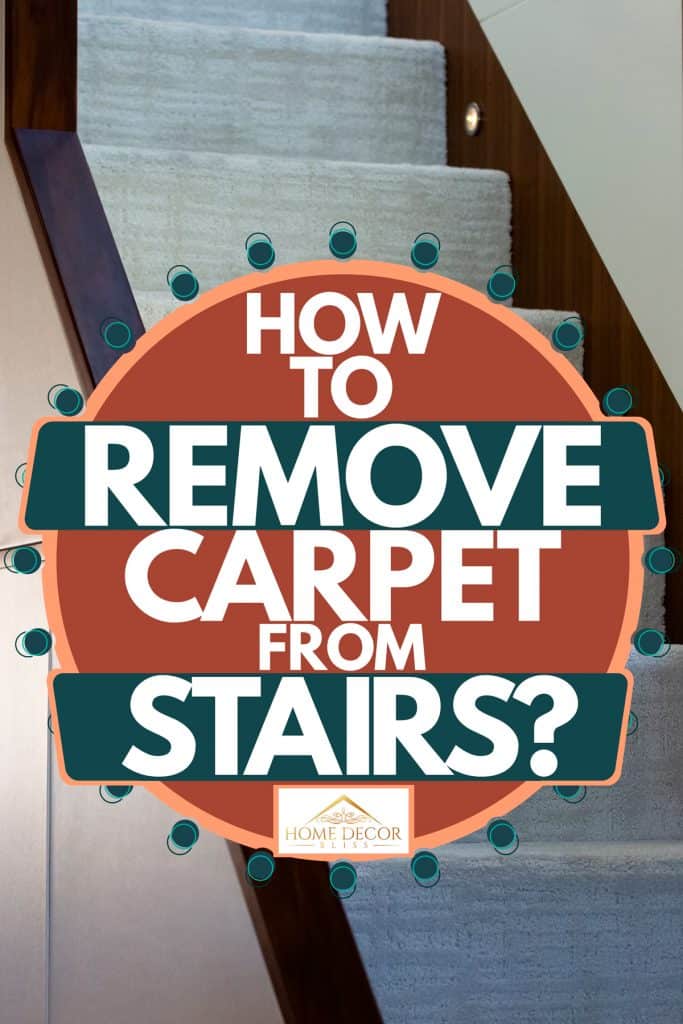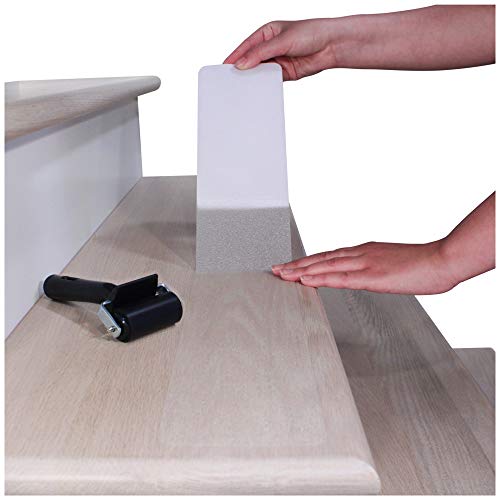If you're contemplating ripping out the old carpet on your stairs, this article is for you! Carpet is a great way to finish a staircase, and a good quality carpet will last for years. However, even the best carpet will eventually wear out and need to be replaced. Tearing the old carpet out will need to be done first and done properly. We've researched the process and have prepared step-by-step instructions for you.
Removing the carpet from your stairs should be a fairly easy task that can be completed in a day. The result should be smooth, bare stairs, ready for refinishing, or new carpet. To accomplish this, follow these five easy steps.
- Loosen the edge of the carpet.
- Pull the carpet up.
- Remove the old carpet padding.
- Pry up the old tack strips.
- Pull out all the staples.
These are basic steps that should be followed to remove carpet from stairs. However, as you continue reading, you will find more in-depth directions, as well as tools that will make your job easier.

Removing Carpet from Stairs
Taking the carpet off a staircase is a fairly simple task, and the right tools will make the job even easier. Here are some materials that you should have on hand as you begin your project.
Materials
- Small pry bar or flathead screwdriver
- Pliers
- Hammer
- Utility knife
- Work Gloves (optional)
1. Loosen the Edge of the Carpet
Beginning at the top of the stairs, cut the edge of the carpet. You can pry the carpet up with a flat head screwdriver or a small pry bar or just use pliers to pull it loose from the tack strips. Sometimes, you may have carpeting at the top of the stairs or on a landing that will remain in place. If this is the case, be sure to leave enough overhang to enable you to fold the carpet under and secure it so that you have a finished edge.
Click here for these razor blade utility knives on Amazon.
2. Pull the Carpet Up
This is where those work gloves will come in handy if you choose to use them. Carpeting on stairs is usually held in place by tack strips and staples. Gloves offer protection against injury. Begin to pull the carpet in a downward motion.
If you're lucky, it was installed as a single piece and will come off in the same way. Sometimes though, each step and riser have its own separate carpet that will need to be removed. Either way, work your way downstairs, pulling up the carpet as you go.
Click here to find these heavy-duty work gloves on Amazon.
3. Remove the Old Carpet Padding
Usually, a carpet has padding installed underneath it. It should be easy to pull up, although it will probably come off in multiple pieces. Occasionally, the underpad will be glued down. In this case, use a putty knife or a scraper to remove all of the padding thoroughly.
Click here for this handy scraper on Amazon.
4. Pry Up the Old Tack Strips
Tack strips are used to keep the carpet in place, preventing wrinkles and trip-hazards. These will need to be removed after the carpet and padding are gone. Pull out your pry bar again, and start prying the tack strips. These don't usually cooperate to come out in one piece, rather tend to splinter and break, so this step often takes some time and patience. One tip for getting it up in longer pieces is to move along the strip's length, gradually prying up each section in increments, instead of just pulling up one end.
Click here to find this small pry bar on Amazon.
5. Pull Out All the Staples
The final step is to pull out those staples! The padding, and maybe even the carpet, was probably tacked down with staples. Use your pliers to grab hold of each staple and remove it. Sometimes, a staple will break off. If this happens, you have two options; either hammer it into the wood or persevere at removing it.
If you plan on installing a new carpet, hammering the broken staple won't hurt a thing. However, if you plan to paint or finish the wood, it is better to go ahead and remove the staple entirely.
Click here for these useful pliers on Amazon.
To learn more about removing carpet from stairs, check out the tutorial featured below.
What Is The Best Flooring To Put On Stairs?
When it comes to deciding what flooring to put on your stairs, there are several options. Each has its pros and cons, which should be considered according to your specific needs. The most popular stair coverings are:
- Carpet
- Hardwood
- Laminate
- Vinyl
- Tile
- Combination
Let's look at each of these separately.
Carpet
Carpet is one of the most popular choices and has a lot to offer. Safety is high on the priority list, and with its high slip-resistance, carpet comes in at the top. It is also the option that offers the most silence and comfort when mounting the stairs. Some of the drawbacks of carpet include its relatively short lifespan and its tendency to retain stains and odors.
Hardwood
Hardwood staircases are timeless, invoking an atmosphere of luxury. You can find many different hardwood types for staircases, but some favorites are oak, teak, ash, mahogany, and bamboo. Hardwoods are durable, easy to clean, and generally age gracefully. The biggest downside to hardwood stairs is the expense. Although there are engineered hardwoods that are more affordable, wood is still one of the most expensive options. Another thing to consider in a wood stair covering is that it has less traction than other choices.
Laminate
Laminate flooring is a great choice for staircases. It offers all the pro's of hardwood, including durability, beauty, and easy maintenance. However, an added benefit is the budget-friendly price tag. While laminate is certainly a cost-effective option, it has its cons as well. Laminate has even less traction than hardwoods, and it is more difficult to install. For a simpler installation, look specifically for laminate stair treads.
Vinyl
Wood-look vinyl has quickly gained popularity as flooring, and more recently, as a valid choice for stair tread. Vinyl is super easy to clean, water-resistant, and easy to install. As we have seen with most of the alternatives, the biggest drawback is the lack of traction in the material. To help with this, consider installing non-slip treading on each step.
Click here to find this non-stick tread tape on Amazon.
Tile
One long-lasting, low maintenance option for your stairs is tile. Ceramic tile and natural stone offer similar benefits, while wood-look tile and accent tiles can create a unique staircase. One negative to this type of flooring is that it can be very cold in the winter. Tile can also be slick, especially when it is wet, and offers a very hard surface in the event of a fall. Natural stone has much more texture than tile, providing a better grip.
Do you love the look of stone? Check out this post, 13 Stone-Effect Wall Murals [#13 Will AMAZE You!]
Combination
Don't like the look of any one of these options? Try combining them! Go for the safety of carpet on your stair treads and the beauty of wood on the risers. Try wood treads and tile risers, or any other combination that fits your style.
Are Carpet Stairs Safer?
Yes, as a standalone cover for stairs, carpet is considered the safest option. However, the addition of stair runner rugs or non-slip treads can dramatically improve the safety of other stair options.
Click here to find stair runners on Amazon.
What Is The Best Carpet Color For Stairs?
The amount of traffic that a staircase accumulates is more than you might think. Stairs also don't get vacuumed as often as other carpets in a home. For this reason, more neutral colors are usually the best choice, as they hide dirt and wear and tear the best. That said, it is usually best to try to match any carpet that may be adjacent to the stairs.
How Do You Replace Carpet On Stairs?
Carpeting on stairs will need to be replaced eventually. Although the process is slightly more difficult than carpet removal, it can be done by most homeowners, saving a considerable amount of money.
Materials Needed
- Carpet
- Carpet padding
- Tack strips
- Staples
- Stapler
- Utility knife
- Measuring tape
- Carpet kicker
Click here for this carpet kicker on Amazon.
Stair Carpet Installation Process
- Thoroughly sweep the entire staircase from top to bottom.
- Measure the length of your carpet by measuring both the tread and riser and adding them together. Add 2-inches to this and multiply it by the number of stairs that you will be carpeting.
- Measure for the width of your carpet by measuring the width of your treads and then adding 2-inches to that measurement.
- Cut your carpet to the proper length and width.
- Install tack strips along the back edge of the tread and along the riser's bottom edge. Tack strips should be the width of the carpet minus 4-inches.
- Measure for and cut the padding. Padding should begin at the tack strip and wrap around the edge of the step. It should be the same width as the tack strips.
- Install the padding beginning at the edge of the tack strip by stapling it securely in place underneath the step.
- Press the carpet into the first tack strip along the bottom edge of the first riser.
- Staple it securely underneath the first stair tread.
- Unfold the carpet over the first tread and place the carpet kicker a couple of inches from the back of the tread.
- Give the carpet kicker a solid "kick" with your knee to tighten up the carpet, and press it into the tack strip at the back of the stair tread.
- Staple the carpet along the back edge of the tread behind the tack strip and along the edge.
- Repeat this process for each subsequent stair step.
- To finish, tuck and staple the carpet underneath the overhang at the top of the stairs.
Conclusion
From ripping out the old carpet to installing new, we hope that this article has been helpful and inspirational for your next DIY stair renovation! Do you get frustrated with short ceilings in your home? You may find inspiration in this post: How to Make Ceilings Look Higher? [5 practical solutions]








